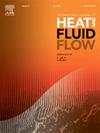Investigation of the heat transfer performance of two-phase flow in a novel step-by-step distributed heat exchanger
IF 2.6
3区 工程技术
Q2 ENGINEERING, MECHANICAL
International Journal of Heat and Fluid Flow
Pub Date : 2024-12-09
DOI:10.1016/j.ijheatfluidflow.2024.109687
引用次数: 0
Abstract
With the miniaturization of electronic chips, and the complexity and diversity of functions, the application of multiple heat source arrays has appeared in recent years. In order to improve the heat dissipation performance of multiple high heat flux chips, this work innovatively designs a step-by-step distributed heat exchanger (SSD), which uses ethanol as coolant and is used for two-phase flow heat dissipation. Then, in order to improve the cooling ability, a crossed step-by-step distributed heat exchanger (CSSD) is proposed by arranging cross flow channels with high heat flux. The VOF two-phase flow numerical method is used to simulate the performance of these two kinds of heat exchangers. In addition, the effects of gravity and inlet height on the performance of the heat CSSD exchanger are studied. The results show that CSSD can shorten the bubble generation time, increases the gas volume fraction in the channel, increase the gas disturbance, and intensify the heat dissipation of two-phase flow compared to the SSD design. The results show that CSSD can reduce the maximum temperature of the heat exchanger and improve the temperature uniformity. Gravity has little effect on two-phase flow heat transfer. In addition, we set up a two-phase flow experimental system to verify the correctness of the numerical simulation. The results indicates that the numerical results are consistent with the experimental results.
求助全文
约1分钟内获得全文
求助全文
来源期刊

International Journal of Heat and Fluid Flow
工程技术-工程:机械
CiteScore
5.00
自引率
7.70%
发文量
131
审稿时长
33 days
期刊介绍:
The International Journal of Heat and Fluid Flow welcomes high-quality original contributions on experimental, computational, and physical aspects of convective heat transfer and fluid dynamics relevant to engineering or the environment, including multiphase and microscale flows.
Papers reporting the application of these disciplines to design and development, with emphasis on new technological fields, are also welcomed. Some of these new fields include microscale electronic and mechanical systems; medical and biological systems; and thermal and flow control in both the internal and external environment.
 求助内容:
求助内容: 应助结果提醒方式:
应助结果提醒方式:


